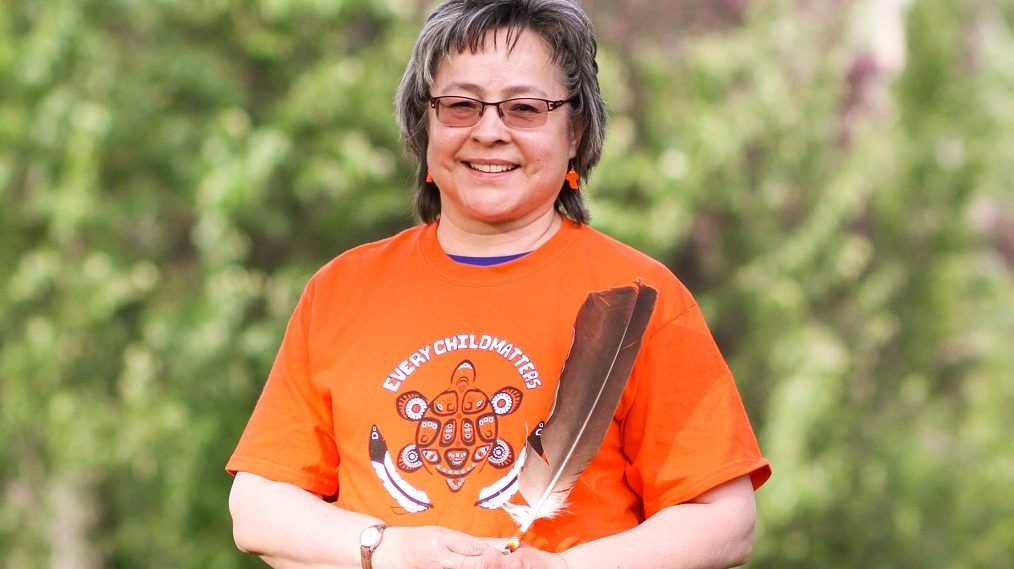For residential school survivor Phyllis Webstad, the colour orange is part of her ‘healing journey’

Posted June 18, 2020 11:58 am.
Last Updated June 18, 2020 12:56 pm.
June is National Indigenous History Month. It is a time for all Canadians — Indigenous, non-Indigenous and newcomers — to reflect upon and learn the history, sacrifices, cultures, contributions, and strength of First Nations, Inuit and Metis people. Throughout the month of June, we will profile Indigenous people, and share their stories and voices, so that we can celebrate the difference they have made in their communities and to our country.
June 18: Today, we celebrate Phyllis Webstad

Phyllis Webstad was born on Dog Creek Reserve, which is located seven hours north of Vancouver. She is Interior Salish from the Stswecem’c (Canoe Creek)/Xgat’tem (Dog Creek) First Nation and they are one of the 17 bands in the Secwepemc (Shuswap) Nation.
“All of us little children were crying and no one cared.”
Phyllis Webstad is a residential school survivor. This is her story in her own words:
“I went to the Mission for one school year in 1973/1974. I had just turned six years old. I lived with my grandmother on the Dog Creek reserve. We never had very much money, but somehow my granny managed to buy me a new outfit to go to the Mission school. I remember going to Robinson’s store and picking out a shiny orange shirt. It had string laced up in front, and was so bright and exciting – just like I felt to be going to school.
When I got to the Mission, they stripped me, and took away my clothes, including the orange shirt! I never wore it again. I didn’t understand why they wouldn’t give it back to me, it was mine! The colour orange has always reminded me of that and how my feelings didn’t matter, how no one cared and how I felt like I was worth nothing. All of us little children were crying and no one cared.”
Residential schools first opened in Canada in 1876 as part of the Indian Act, tailored to strip Indigenous children of their culture and assimilate them into Euro-Canadian society. More than 150,000 Indigenous children – First Nations, Inuit and Métis – attended these schools. Many of the children were physically and sexually abused, and dealt with other harsh conditions. It is estimated that more than 6,000 children died in residential schools.
“The colour orange has always reminded me of that and how my feelings didn’t matter, how no one cared and how I felt like I was worth nothing.”
Webstad was 13 years old when her son Jeremy was born.
“Because my grandmother and mother both attended residential school for 10 years each, I never knew what a parent was supposed to be like. With the help of my aunt, Agness Jack, I was able to raise my son and have him know me as his mother.”
Four generations of Webstad’s family attended residential schools.
At the age of 27, she entered a treatment centre and has “been on this healing journey ever since then.” Part of that journey involved being the voice for Orange Shirt Day in Canada – held annually on September 30 since 2013.
“Orange Shirt Day is a day to have conversation about all aspects of Indian residential school. It is a day to honour Indian residential and day school survivors and their families, and to remember those that did not make it. What it means to me is that we can start talking about what happened to us and maybe heal some and make some peace with our experiences.”
Webstad explains why she decided to create books about Orange Shirt Day:
“I was being asked to talk in elementary schools, it was hard to just be me there and try to tell them about my experience. I thought if I had some pictures with the story I could tell the story better so that they understood more, so I created The Orange Shirt Story in 2018 for kindergarten to about age eight, and another in 2019 called Phyllis’ Orange Shirt for ages four to six.
A third book goes off to print called Orange Shirt Day and will be available to purchase in many bookstores across Canada on Aug. 18. This one is text book style, for Grade 5 and up. It is a resource for teachers as well as parents and those in the corporate world wanting to know more about Orange Shirt Day, the reason and history behind the day, and why it’s important.”
“This isn’t just Indigenous history, this is Canadian history. It’s time for Canadians to learn the truth about what happened to us. One day, in as little as 50 years, there will be no survivors left in Canada so the time to tell our truths is now. I ask Canadians to listen to survivors with an open heart, no judgment.”
To learn more about Webstad’s story, click here.
To find out how you can support Orange Shirt day, click here.








